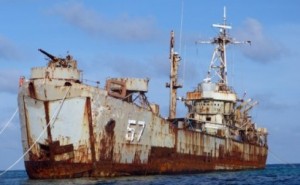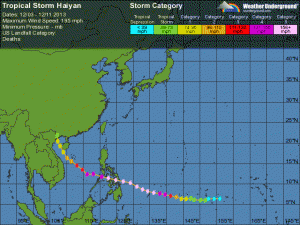The U.S. and Japan must consider the potential geopolitical impact of Super-Typhoon Haiyan/Yolanda. This natural disaster will “change the game” in the South China Sea–The demand for disaster recovery assets alone will force the rapid deterioration of the Philippines’ ability to support their South China Sea outposts, leading to further Chinese encroachment (though some Filipino news outlets are wasting no time in cheering that the Typhoon forced Chinese ships to temporarily vacate the region).
If we assume that China is already preparing to grab additional sea features in the super-storm’s aftermath, then both the United States and Japan should change the game themselves, take the initiative, and direct some HA/DR resources towards the South China Sea outposts–all in the name of stability and in “helping the cut-off, typhoon-impacted islands and residents of the South China Seas.”
Such a step would be a savvy way for the U.S./international community to offer support to ALL South China Sea players, while, at the same time, sidestepping the tacitly unrecognized Chinese blockade of certain Vietnamese and Filipino islands.
Look, these tiny Vietnamese and Filipino “trip wires” need food and (in some cases) shelter, and if their fall to China is inevitable, would it not be of value to force China to declare a formal blockade? Publicly announcing what is, in effect, an act of aggression? It wouldn’t change anything on the ground, but the enormous regional political impact would do a lot to improve U.S. regional standing and help encourage more substantive regional efforts to resolve the festering South China Sea territorial disputes.
As it is, the region dodged a bullet. The eye of the super-storm came within 150-175 miles of some Spratly Island hotspots–had the storm gone a bit farther south, smaller outposts would have been wiped out, and China would undoubtably move quickly to exploit their absence in extending their South China Sea island holdings.
Apparently, the Filipino tripwire outposts survived. Here’s one status update on the Filipinos aboard the decrepit World War II-era LST, the Sierra Madre, via the Philippine Daily Inquirer:
While Yolanda was barreling her way toward Palawan, I remembered the sailors and Marines stationed in “the loneliest outpost of the Armed Forces.” As I mentioned last week, we have eight Navy personnel living on a rusting relic of World War II, the Sierra Madre that was grounded on the Ayungin Shoal sometime in 1999.
I checked with the Philippine Navy, and the officer in charge for public affairs, Lt. Commander Gregory V. Fabic of PMA Class ’97 informed me that the men on the Ayungin Shoal were in good spirits in spite of living conditions made more difficult by Yolanda.
Now, if you have not already, take a minute to experience the innovative (and long overdue) New York Times multimedia report from the derelict Sierra Madre. And then take another minute to consider that there are a few Philippines outposts even more worse-off than the grounded Sierra Madre:
The settlements on Rizal Reef, Patag and Panata are mostly crude stilted structures over shallow water or small sandbars, with very little room to maneuver and fishing as the sole activity and consolation. According to Bito-onon, the troops on Rizal Reef used to tie themselves to empty oil drums when there was particularly bad weather at night, so that if a high sea or an errant piece of ocean debris wiped out the stilts, they’d at least be able to float.
 Hopefully the folks at those outposts survived. The New York Times story is very vivid (if you want to know what life aboard a wreck is like) and captures the Philippines utter unpreparedness to maintain sovereignty under a well-resourced, continuous foreign blockade, or as the reporters put it, a “cabbage strategy”, enveloping reefs in a blanket of Chinese fishermen, Coast Guard and Navy ships:
Hopefully the folks at those outposts survived. The New York Times story is very vivid (if you want to know what life aboard a wreck is like) and captures the Philippines utter unpreparedness to maintain sovereignty under a well-resourced, continuous foreign blockade, or as the reporters put it, a “cabbage strategy”, enveloping reefs in a blanket of Chinese fishermen, Coast Guard and Navy ships:
There can be no question that the cabbage strategy is in effect now at Ayungin and has been at least since May. General Zhang, in his interview several months ago, listed Ren’ai Shoal (the Chinese name for Ayungin) in the P.L.A.’s “series of achievements” in the South China Sea. He had already put it in the win column, even though eight Filipino marines still live there. He also seemed to take some pleasure in the strategy. Of taking territory from the Philippines, he said: “We should do more such things in the future. For those small islands, only a few troopers are able to station on each of them, but there is no food or even drinking water there. If we carry out the cabbage strategy, you will not be able to send food and drinking water onto the islands. Without the supply for one or two weeks, the troopers stationed there will leave the islands on their own. Once they have left, they will never be able to come back.”
For the uninitiated, that is called a blockade. The Philippines are already stretched to the limit–back in October, Chinese pressure had forced resupply to a halt at the Sierra Madre and resupply was becoming sporadic at other, larger Filipino posts. The soldiers manning the old vessel were already reduced to fishing to survive. Haiyan/Yolanda recovery efforts will only eat away at any of the few reliable Filipino logistical assets available for island support, offering China a real opening to grab more territory.
Rather than wait for China to seize the islands, it is time for the U.S. to get out there, do a safety check, help the Filipino soldiers build up some MRE stockpiles, refresh their communications equipment, and, if possible, arrange safer, more habitable living arrangements (time to take a page from the Chinese playbook, eh?). Failing that, it just would be strategically wise to push China into making her intentions clear on the international stage, and get these long-standing unofficial and deliberately “overlooked” island blockades recognized for what they are.
Such a move would also make it very clear that America’s “pivot” to the Pacific is real, and that the U.S. (and, say, Japan) will not hesitate to brush China back from the plate a bit.
I propose this because the current non-confrontational path is not working. Regional progress in favorably resolving the South China Seas–in developing a Regional Code of Conduct, or a path forward in maritime border disputes–will be only be made in a crisis. And I, for one, prefer stoking some smaller, more easily managed and more easily defused crises than by staying passive. Why give China the initiative to spark a crisis when the tactical situation suits? Inaction is, frankly, dangerous. By allowing China the luxury of waging undeclared blockades and creeping non-aggressive aggression, the world only stokes China’s apatite for geopolitical risk and opens avenues for a far higher-stakes miscalculation. A risk taken now will help prevent a larger risk later.
It is time for the U.S. to make a move.


{ 4 comments… read them below or add one }
Heh.. Yeah, I understand….But, well, then we can all hope to be pleasantly surprised, right? Just as we were when we zipped into the heart of Pakistan to off Bin Ladin–which was, you gotta admit, pretty gutsy.
Wonder if they discussed this at the big White House meeting last night.
The problem is … you need a commander-in-chief with the Balls to do it. China knows who leads this country.
Interesting perspective. I have nothing against China developing military forces and so forth–I’d be building my Navy if the roles were reversed. What I do worry about is the expansionist impulses (which again, I understand the rationale for it). My concern is how the different parties manage themselves in the years ahead. Thanks for commenting!
In my opinion, the US must develop and maintain a Pacific strategy that is beneficial to the USA of the 21st Century, NOT the cold war USA of the 20th Century.
A lot of the background facts discussed in this article are painted using the frame work of the obsolete Cold War Strategies employed by the USA.
Certainly, this recent epic typhoon has upended the tennuous balance in the South China Sea.
Almost certainly, oil rigs were damaged and destroyed…….and my guess is that there will be a huge wave of Chinese investment in re-building these production facilities. For the US to fight this would be the same as fighting the tide…….doomed to failure.
The mass of humanity in China is devouring every fish in the sea. Typhoon Haiyan has probably blown away every vestige of Vietnamese and Philipino attempt to maintain sovereignity over fishing banks……
I think it would be far wiser for USA to rebuild its infrastructure in the Philipines so as to maintain and grow…..energy independence and aqua culture. Abandon the indefensible offshore oil rigs in favor of Solar Power and preferential sales of oil from US/Aussie Oil Distributors. Demand preferential treatment for US investment in aquaculture projects to grow the foods for the 21st Century, rice, fish, fruits, vegetables! and also, float contracts for re-building Subic Bay Naval Base and other AirForce/army Facilities around the Philipine Islands………